UTC Living Streets Presentation 7.21.21 — original pdf
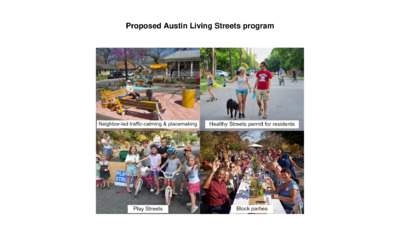
Proposed Austin Living Streets program Neighbor-Led Traffic Calming and Placemaking: Healthy Streets Permit for Residents: Play Streets: Thank you! www.AustinLivingStreets.com

Proposed Austin Living Streets program Neighbor-Led Traffic Calming and Placemaking: Healthy Streets Permit for Residents: Play Streets: Thank you! www.AustinLivingStreets.com
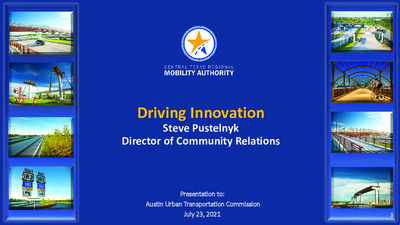
Driving Innovation Steve Pustelnyk Director of Community Relations Presentation to: Austin Urban Transportation Commission July 23, 2021 1 About the Mobility Authority • A multi-modal transportation agency authorized under 2001 state legislation • A regional agency formed in 2002 by Williamson and Travis Counties • Toll revenue primary source of funding • No taxing authority • Oversight by a seven-member board of business and community leaders • 29 employees 2 Agency Leadership Heather Gaddes Board Member Williamson County Appointee - 2021 Secretary James Bass Executive Director 3 The Mobility Authority System • 183A • 290 Toll (Manor Expressway) • 71 Toll • 45 SW Toll • MoPac Express • 183 Toll South • 183 North Express 4 Some Things To Ponder Is Disruptive Change Around the Corner? • How will the transition to Roadway Usage Charges (RUC) impact the transportation ecosystem? • How will/should climate change impact our mobility decisions? • How will the growth of Connected Autonomous Shared Electric (CASE) vehicles change the way we design, finance, construct, operate and maintain our roadways? • How might remote work, shared vehicle ownership, air taxis, delivery drones and autonomous public transit change the mobility paradigm? • What other disruptive forces might be out there (COVID)? 5 Weekly Transaction Trend (All Roads) Percent Change in Transactions Since First Week of March 2020 Other Roads 183 South Percent Change 183 Toll Phase 2 Opens Winter Storm 4,000,000 3,500,000 3,000,000 2,500,000 2,000,000 1,500,000 1,000,000 s n o i t c a s n a r T - COVID 4 6 0 , 7 4 6 , 2 500,000 -60.9% 1 / 3 k e e W 8 / 3 k e e W 5 1 / 3 k e e W 2 2 / 3 k e e W 9 2 / 3 k e e W 5 / 4 k e e W 2 1 / 4 k e e W 9 1 / 4 k e e W 6 2 / 4 k e e W 3 / 5 k e e W 0 1 / 5 k e e W 7 1 / 5 k e e W 4 2 / 5 k e e W 1 3 / 5 k e e W 7 / 6 k e e W 4 1 / 6 k e e W 1 2 / 6 k e e W 9 2 / 6 …
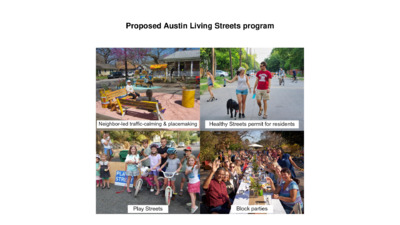
Proposed Austin Living Streets program Neighbor-Led Traffic Calming and Placemaking: Healthy Streets Permit for Residents: Play Streets: Thank you! www.AustinLivingStreets.com
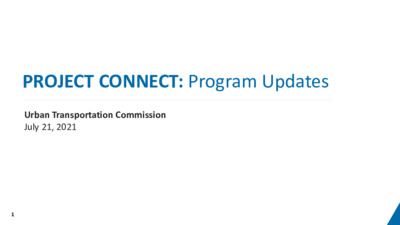
PROJECT CONNECT: Program Updates Urban Transportation Commission July 21, 2021 1 Recent Project Connect Program Updates: • $2.88 million Federal Transit Administration (FTA) grant for 40-foot electric buses, charging equipment, workforce training, and technical assistance. • Capital Metro and Austin F.C. approval of a funding partnership agreement for a new McKalla Station at Q2 Stadium. • Launch of Capital Metro’s 9th Pickup zone (North Dessau) in June. South Menchaca zone launches July 27, and North Oak Hill in the fall. • Completion of 15-percent design drawings for Orange and Blue Line; letters to FTA requesting entry into the New Starts capital grant program submitted. • $36 million in FTA Small Starts grant funding included in the President’s FY2022 budget for MetroRapid Pleasant Valley and Expo Lines 2 PROJECT CONNECT PROGRAM COMPONENTS: PROJECT CONNECT – PROGRAM COMPONENTS Orange Line – NLTC to Stassney Phase 1 (LRT), Enhanced MetroRapid Blue Line – Riverside Corridor (LRT) Gold Line – MetroRapid, NEPA completion for LRT Downtown Tunnel (Orange, Blue Lines) MetroRapid – Expo, Pleasant Valley, Burnet to Menchaca/Oak Hill Green Line to Colony Park – NEPA, Final Design, Construction Red Line Improvements MetroExpress, Park & Rides, Transit Centers (3 New Routes, 9 P&R, 1 TC) Neighborhood Circulators (15 New Zones / Vehicles) Maintenance Facility Improvements Customer Technology Systems Anti-Displacement Investments ($300 million) 3 PROGRAM SEQUENCE PLAN Years based on federal NEPA and funding approvals 4 Orange & Blue Line Projects – Implementation Timeline June 2020 Orange & Blue Line Locally Preferred Alternatives (LPAs) Adopted Project Connect Referendum Passed Ongoing Community Engagement and Involvement 2023 – 2029 Projected Entry Into FTA Engineering Phase Design and Contracting Procurement Awards Begin Construction and Vehicle Manufacturing Projected Full Funding Grant Agreement(s) (FFGA) Staffing, Training, Organizational Readiness Revenue Service Begins 5 Orange & Blue Line Key Milestones (2021 – 2022) April 2021 Summer 2021 Spring 2022 Spring – Summer 2022 National Environmental Policy Act (NEPA) Notice of Intent Complete 15% Design Request to Enter FTA Project Development Initial FTA Rating Complete 30% Design and Cost Estimate Summer 2022 Winter 2022 Draft Environmental Impact Statement (DEIS), Draft 30% Design and Cost Estimates 2023 - Beyond 6 End of EIS and 30% Design Comment Phase Final EIS (FEIS) Complete FTA NEPA Record of Decision (ROD) Project Connect MetroRapid Milestones – Expo & Pleasant Valley April 2021 Spring – Summer 2021 Winter 2021 – Spring 2022 Complete 30% Design and Cost Estimates …
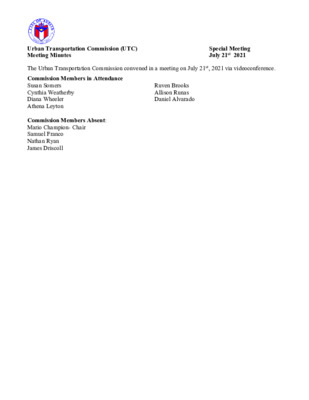
Urban Transportation Commission (UTC) Meeting Minutes Special Meeting July 21st 2021 The Urban Transportation Commission convened in a meeting on July 21st, 2021 via videoconference. Ruven Brooks Allison Runas Daniel Alvarado Commission Members in Attendance Susan Somers Cynthia Weatherby Diana Wheeler Athena Leyton Commission Members Absent: Mario Champion- Chair Samuel Franco Nathan Ryan James Driscoll CALL TO ORDER Commissioner Somers called the meeting to order at 3:05 p.m. 1. APPROVAL OF MINUTES: June 17th, 2021 MEETING The June 17th, 2021 minutes were approved on a 7-0 vote with Commissioners Champion, Franco, Ryan and Driscoll absent. 2. NEW BUSINESS A. Living Streets Presentation: Discussion and Possible Action Presenters: Chris Riley B. Project Connect Update: Discussion and Possible Action Presenters: Conte Liane and Annick Beaudet C. CTRMA Update: Discussion and Possible Action Presenters: Steve Pustelnyk 3. Staff and Committee Reports No updates given 4. Future Agenda Items • FY 21-22 Budget ADJOURNMENT Commissioner Somers adjourned the meeting at 5:00p.m. without objection.
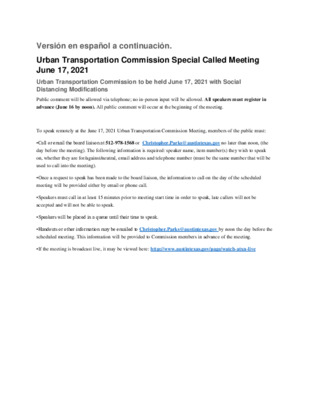
Versión en español a continuación. Urban Transportation Commission Special Called Meeting June 17, 2021 Urban Transportation Commission to be held June 17, 2021 with Social Distancing Modifications Public comment will be allowed via telephone; no in-person input will be allowed. All speakers must register in advance (June 16 by noon). All public comment will occur at the beginning of the meeting. To speak remotely at the June 17, 2021 Urban Transportation Commission Meeting, members of the public must: •Call or email the board liaison at 512-978-1568 or Christopher.Parks@austintexas.gov no later than noon, (the day before the meeting). The following information is required: speaker name, item number(s) they wish to speak on, whether they are for/against/neutral, email address and telephone number (must be the same number that will be used to call into the meeting). •Once a request to speak has been made to the board liaison, the information to call on the day of the scheduled meeting will be provided either by email or phone call. •Speakers must call in at least 15 minutes prior to meeting start time in order to speak, late callers will not be accepted and will not be able to speak. •Speakers will be placed in a queue until their time to speak. •Handouts or other information may be emailed to Christopher.Parks@austintexas.gov by noon the day before the scheduled meeting. This information will be provided to Commission members in advance of the meeting. •If the meeting is broadcast live, it may be viewed here: http://www.austintexas.gov/page/watch-atxn-live Llamado especial Urban Transportation Commission FECHA de la reunion (June 17, 2021) La junta se llevará con modificaciones de distanciamiento social Se permitirán comentarios públicos por teléfono; no se permitirá ninguna entrada en persona. Todos los oradores deben registrarse con anticipación (June 16, 2021 antes del mediodía). Todos los comentarios públicos se producirán al comienzo de la reunión. Para hablar de forma remota en la reunión, los miembros del público deben: • Llame o envíe un correo electrónico al enlace de junta en 512-978-1568 o Christopher.Parks@austintexas.gov a más tardar al mediodía (el día antes de la reunión). Se requiere la siguiente información: nombre del orador, número (s) de artículo sobre el que desean hablar, si están a favor / en contra / neutral, dirección de correo electrónico (opcional) y un número de teléfono (debe ser el número que se utilizará para llamar ). • Una vez que se haya realizado …
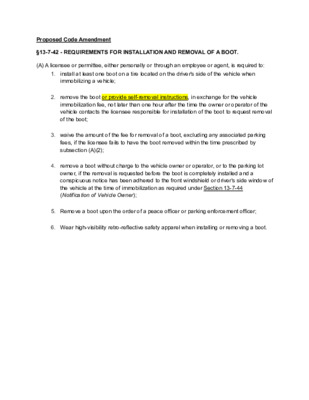
Proposed Code Amendment §13-7-42 - REQUIREMENTS FOR INSTALLATION AND REMOVAL OF A BOOT. (A) A licensee or permittee, either personally or through an employee or agent, is required to: install at least one boot on a tire located on the driver's side of the vehicle when immobilizing a vehicle; 1. 2. remove the boot or provide self-removal instructions, in exchange for the vehicle immobilization fee, not later than one hour after the time the owner or operator of the vehicle contacts the licensee responsible for installation of the boot to request removal of the boot; 3. waive the amount of the fee for removal of a boot, excluding any associated parking fees, if the licensee fails to have the boot removed within the time prescribed by subsection (A)(2); 4. remove a boot without charge to the vehicle owner or operator, or to the parking lot owner, if the removal is requested before the boot is completely installed and a conspicuous notice has been adhered to the front windshield or driver's side window of the vehicle at the time of immobilization as required under Section 13-7-44 (Notification of Vehicle Owner); 5. Remove a boot upon the order of a peace officer or parking enforcement officer; 6. Wear high-visibility retro-reflective safety apparel when installing or removing a boot.
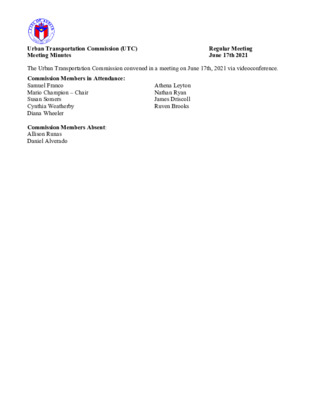
Urban Transportation Commission (UTC) Meeting Minutes Regular Meeting June 17th 2021 The Urban Transportation Commission convened in a meeting on June 17th, 2021 via videoconference. Commission Members in Attendance: Samuel Franco Mario Champion – Chair Susan Somers Cynthia Weatherby Diana Wheeler Commission Members Absent: Allison Runas Daniel Alverado Athena Leyton Nathan Ryan James Driscoll Ruven Brooks CALL TO ORDER Commissioner Champion called the meeting to order at 1:00 p.m. 1. APPROVAL OF MINUTES: June 17th, 2021 MEETING The May 12th 2021 minutes were approved on a 9-0 vote with Commissioners Runas and Alvarado absent. 2. NEW BUSINESS A. Discussion and Possible Action: Amend City Code Related to vehicle “Boots” Proposed Code Amendment language was discussed and after debate and discussion, read as follows. [A licensee or permittee, either personally or through an employee or agent, is required to: 1.) install at least one boot on a tire located on the driver's side of the vehicle when immobilizing a vehicle] And [2.) remove the boot or provide self-removal instructions, in exchange for the vehicle immobilization fee, not later than one hour after the time the owner or operator of the vehicle contacts the licensee responsible for installation of the boot to request removal of the boot;] A motion to amend city code recommendation was approved on a 9-0 vote with Commissioners Runas and Alvarado absent. •ARGO – developers of self-driving technology briefing 3. Staff and Committee Reports No updates given 4. Future Agenda Items •Booting Cost Comparisons •South Central Waterfront update •Electric Scooters Update •Great Streets Update •Project Connect Briefing/ Update •CAMPO Updates •TxDOT Update •Budget Report from ATD Rob Spillar and Richard Mendoza •CTRMA Update •CAPCOG update ADJOURNMENT Commissioner Champion adjourned the meeting at 1:47p.m. without objection.
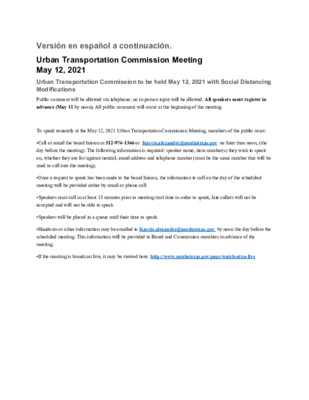
Versión en español a continuación. Urban Transportation Commission Meeting May 12, 2021 Urban Transportation Commission to be held May 12, 2021 with Social Distancing Modifications Public comment will be allowed via telephone; no in-person input will be allowed. All speakers must register in advance (May 11 by noon). All public comment will occur at the beginning of the meeting. To speak remotely at the May 12, 2021 Urban Transportation Commission Meeting, members of the public must: •Call or email the board liaison at 512-974-1366 or Kaycie.alexander@austintexas.gov no later than noon, (the day before the meeting). The following information is required: speaker name, item number(s) they wish to speak on, whether they are for/against/neutral, email address and telephone number (must be the same number that will be used to call into the meeting). •Once a request to speak has been made to the board liaison, the information to call on the day of the scheduled meeting will be provided either by email or phone call. •Speakers must call in at least 15 minutes prior to meeting start time in order to speak, late callers will not be accepted and will not be able to speak. •Speakers will be placed in a queue until their time to speak. •Handouts or other information may be emailed to Kaycie.alexander@austintexas.gov by noon the day before the scheduled meeting. This information will be provided to Board and Commission members in advance of the meeting. •If the meeting is broadcast live, it may be viewed here: http://www.austintexas.gov/page/watch-atxn-live Reunión del Urban Transportation Commission la FECHA de la reunion (May 12, 2021) La junta se llevará con modificaciones de distanciamiento social Se permitirán comentarios públicos por teléfono; no se permitirá ninguna entrada en persona. Todos los oradores deben registrarse con anticipación (May 11, 2021 antes del mediodía). Todos los comentarios públicos se producirán al comienzo de la reunión. Para hablar de forma remota en la reunión, los miembros del público deben: • Llame o envíe un correo electrónico al enlace de junta en 512-974-1366 o Kaycie.alexander@austintexas.gov a más tardar al mediodía (el día antes de la reunión). Se requiere la siguiente información: nombre del orador, número (s) de artículo sobre el que desean hablar, si están a favor / en contra / neutral, dirección de correo electrónico (opcional) y un número de teléfono (debe ser el número que se utilizará para llamar ). • Una vez que se haya …
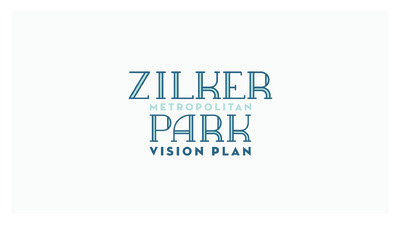
M E T R O P O L I TA N V I S I O N P L A N URBAN TRANSPORTATION COMMISSION MEETING MAY 12, 2021 NELSON \ NYGAARD AGENDA 1. Introduction 2. Site Analysis and Needs Assessment Report Overview 3. Discussion 4. Goals and Guiding Principals | 1 Site Analysis and Needs Assessment INTRODUCTION TEAM OVERVIEW City of Austin Design Workshop Prime Consultant Landscape Architecture/Urban Planning Community & Key Stakeholders Engagement & Equity Economics Environmental, Ecology & Land Use Historical Preservation & Cultural Resources Infrastructure CD&P Buie & Co. Kardia Advisory Group HR&A Charlie McCabe Consulting Majestic Services, Inc Siglo Group Drenner Group MuseWork Limbacher & Godfrey Nelson/Nygaard GarzaEMC Encotech Altura Solutions | 3 Site Analysis and Needs Assessment CLIENT/TAG OVERVIEW Client Group Technical Advisory Group Parks and Recreation Department City of Austin Ricardo Soliz Gregory Montes Megan Eckard Justin Schneider Kasey Corpus PARD ATD Public Works Watershed Protection Office of Real Estate Services Marketing and Communications Office Austin Water Austin Energy Management Services Austin Resource Recovery Cap Metro TXDOT | 4 Site Analysis and Needs Assessment SCHEDULE SMALL GROUP DISCUSSIONS PROJECT KICK-OFF FEB 1ST COMMUNITY MEETING #1 INTRO TO THE PROJECT COMMUNITY MEETING #3 ALTERNATIVES COMMUNITY MEETING #5 (IF NEEDED) FEB MAR APR MAY JUN JUL AUG SEP OCT NOV DEC JAN FEB MAR APR TAG KICK-OFF MEETING COMMUNITY MEETING #2 PROGRAMMING COMMUNITY MEETING #4 DRAFT PLAN FINAL VISION PLAN Strategic Kick-Off and Project Initiation Site and Contextural Analysis and Data Project Meetings Stakeholder/Community Participation City Staff, Public Review/Boards, Commissions, Council Review Vision Plan Report Preparation Project Work Plan Kick-Off Meeting Site Analysis and Needs Assessment Report Project Meetings Materials Community Outreach and Draft Vision Plan Presentation of the Site Analysis and Stakeholder Contract Engagement Plan Final Draft Vision Plan Document Technical Advisory Group Meetings Needs Assessment Report List Meeting Minutes and Summaries Community Engagement and Outreach Presentation of Final Draft Vision Plan Document to City Commission, Progress Reports Presentation of the Site Analysis and Needs Boards, City Manager and City Council Provide a Needs Assessment Report Preliminary Vision Plan Concepts Final Vision Plan Document Assessment Report to City Commission, Boards, City Manager and City Council Community Wide Survey | 5 Site Analysis and Needs Assessment SITE ANALYSIS AND NEEDS ASSESSMENT REPORT REGIONAL CONTEXT RED BUD ISLE C O L O R A D O R I V E R UT AUSTIN K E E R …
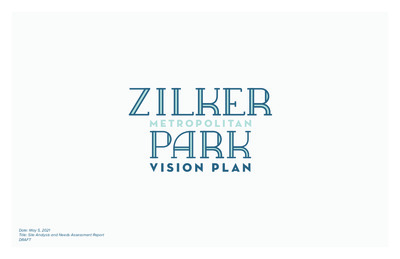
M E T R O P O L I TA N V I S I O N P L A N Date: May 5, 2021 Title: Site Analysis and Needs Assessment Report DRAFT INTRODUCTION Zilker Metropolitan Park (Zilker Park) was designated as a public park in 1934. With lands donated in 1917 by Andrew Jackson Zilker, the history of the park’s land goes back farther – 9,000 years or more. Today, with approximately 350 acres of area to explore, Zilker Park is a complex blend of precious environmental resources, events that have become tradition, economic income for the City and a symbol of Austin life. No comprehensive plan has ever been done on the park until this initiative. With the vast number of stakeholders, users, and complicated regulations that exist within the Park, a plan is long overdue. It will provide direction for Zilker Park’s improvements for the next several decades. Many plans and studies have been done on various elements or aspects of Zilker Park in the past decade. In addition to providing regional, demographic, economic, environmental and transportation- related context, this report summarizes the more recent plans and recommendations. CONTENTS INTRODUCTION . . . . . . . . . . . . . . . . . . . . . . . . . . . . . . . . . . . . . . . . . . . REGIONAL CONTEXT . . . . . . . . . . . . . . . . . . . . . . . . . . . . . . . . . . . . . 1 2 3 5 6 ZILKER PARK ECOLOGICAL CONTEXT ZILKER PARK IN OVERALL AUSTIN PARK SYSTEM ZILKER PARK CONTEXT MAP ZILKER PARK BOUNDARY MAP DEMOGRAPHICS . . . . . . . . . . . . . . . . . . . . . . . . . . . . . . . . . . . . . . . . . 9 10 11 POPULATION PROJECTION IN AUSTIN THE NUMBER OF VISITOR IN ZILKER ENVIRONMENT . . . . . . . . . . . . . . . . . . . . . . . . . . . . . . . . . . . . . . . . . .13 14 ENVIRONMENTAL CONTEXT …
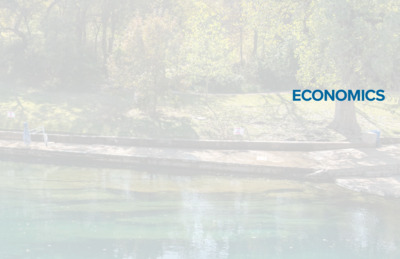
ECONOMICS ECONOMICS With the arrival of the Covid-19 pandemic, most city parks agencies as well as nonprofit park partners saw tremendous drops in revenue as most events and in-person programming were curtailed in the past year. While this is slowly changing with the rollout of vaccines, it is unclear how quickly such revenues will recover. Further, as documented by research done by the National Recreation and Parks Association and researchers at Pennsylvania State University, economic downturns cause particular challenges for parks systems. Parks and recreation agencies are the first to see budget cuts and the last to see cuts restored, as documented by studies looking at the period 2003-2013. Further, any funds collected through concession agreements as well as park usage fees (pool admission fees, rentals of picnic sites, event locations like the Zilker Clubhouse or even large multi-day events like the Austin City Limits Music Festival) are paid into the City’s general fund, a portion of which are “returned” to the Parks and Recreation department via annual budget appropriations. The parks department, by and large, does not keep any of the fees collected by city ordinance directly, but shares in them. This is true in most U.S. cities for park fees. Finally, while nonprofits can raise funds and apply those funds for park improvements, programming and operations, those funds collectively are a small portion of total park spending. Based on research performed by The Trust for Public Land, six percent of annual spending in the 100 largest U.S. cities for parks comes from nonprofit park organizations. For Austin specifically, TPL’s ParkScore index reported in 2020 that 13% of funding came from a dozen park nonprofits, totaling $20.7M, putting Austin #17 out of 100 in terms of nonprofit funding share. The bulk of this spending for capital projects by APF, The Trail Foundation, Pease Park Conservancy, Waterloo Greenway and others. This section will detail concession revenue for Zilker Park and event and other fee revenue. Events in Zilker are governed by city ordinances and practices that grew out of recommendations from the Parkland Events report in 2017. These 44 | Site Analysis and Needs Assessment CONCESSION TERM ANNUAL PAYMENT PERCENTAGE OF GROSS CAPITAL INVESTMENT EXTENSIONS OTHER NOTES Zilker Canoe & Kayak Originated: 2/2/06; 4 10% up to $180,000 in income $35,000 in site improvements from 2/2/06 to 2/2/13 Reassess every 12 months Unclear who owns boats, improvements. Zilker Train Previous …
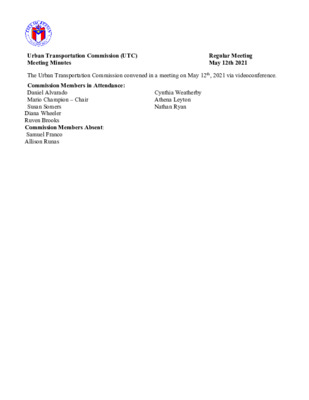
Urban Transportation Commission (UTC) Meeting Minutes Regular Meeting May 12th 2021 The Urban Transportation Commission convened in a meeting on May 12th, 2021 via videoconference. Commission Members in Attendance: Daniel Alvarado Mario Champion – Chair Susan Somers Diana Wheeler Ruven Brooks Commission Members Absent: Samuel Franco Allison Runas Cynthia Weatherby Athena Leyton Nathan Ryan CALL TO ORDER Commissioner Champion called the meeting to order at 1:01 p.m. 1. APPROVAL OF MINUTES: April 15th, 2021 MEETING The April 15, 20210 minutes were approved on a unanimous 8-0 vote with Commissioners Franco and Runas absent 2. NEW BUSINESS A. Briefing of the Zilker Park Vision Plan Site Analysis and Existing Conditions Report Including Guiding Principals Presenters: Gregory Montes, Claire Hempel, Jonathan Mosteiro, Lauren Mattern and Jacob Francis Members were briefed and took no action 3. FUTURE AGENDA ITEMS No items discussed. ADJOURNMENT Commissioner Champion adjourned the meeting at 2:26 p.m. without objection.
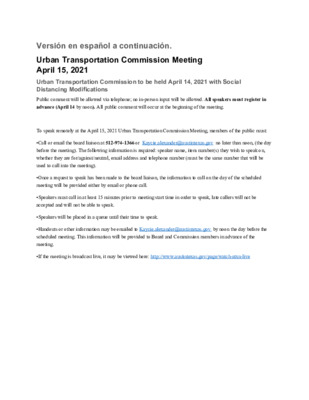
Versión en español a continuación. Urban Transportation Commission Meeting April 15, 2021 Urban Transportation Commission to be held April 14, 2021 with Social Distancing Modifications Public comment will be allowed via telephone; no in-person input will be allowed. All speakers must register in advance (April 14 by noon). All public comment will occur at the beginning of the meeting. To speak remotely at the April 15, 2021 Urban Transportation Commission Meeting, members of the public must: •Call or email the board liaison at 512-974-1366 or Kaycie.alexander@austintexas.gov no later than noon, (the day before the meeting). The following information is required: speaker name, item number(s) they wish to speak on, whether they are for/against/neutral, email address and telephone number (must be the same number that will be used to call into the meeting). •Once a request to speak has been made to the board liaison, the information to call on the day of the scheduled meeting will be provided either by email or phone call. •Speakers must call in at least 15 minutes prior to meeting start time in order to speak, late callers will not be accepted and will not be able to speak. •Speakers will be placed in a queue until their time to speak. •Handouts or other information may be emailed to Kaycie.alexander@austintexas.gov by noon the day before the scheduled meeting. This information will be provided to Board and Commission members in advance of the meeting. •If the meeting is broadcast live, it may be viewed here: http://www.austintexas.gov/page/watch-atxn-live Reunión del Urban Transportation Commission la FECHA de la reunion (April 15, 2021) La junta se llevará con modificaciones de distanciamiento social Se permitirán comentarios públicos por teléfono; no se permitirá ninguna entrada en persona. Todos los oradores deben registrarse con anticipación (April 14, 2021 antes del mediodía). Todos los comentarios públicos se producirán al comienzo de la reunión. Para hablar de forma remota en la reunión, los miembros del público deben: • Llame o envíe un correo electrónico al enlace de junta en 512-974-1366 o Kaycie.alexander@austintexas.gov a más tardar al mediodía (el día antes de la reunión). Se requiere la siguiente información: nombre del orador, número (s) de artículo sobre el que desean hablar, si están a favor / en contra / neutral, dirección de correo electrónico (opcional) y un número de teléfono (debe ser el número que se utilizará para llamar ). • Una vez que se haya …
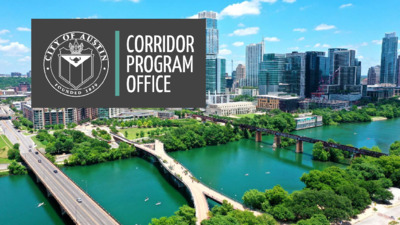
URBAN TRANSPORTATION COMMISSION UPDATE Presenters: Kathleen Rubin, Anna Martin City of Austin April 15, 2021 AGENDA INTRODUCTION BACKGROUND PROGRAM STATUS & PROGRESS KEY SUCCESS FACTORS CCP & PROJECT CONNECT NEXT STEPS QUESTIONS 3 BACKGROUND Presenter: Kathleen Rubin, Capital Improvement Program Manager, Corridor Program 4 2016 MOBILITY BOND PROGRAM $720 Million • $137M Local Mobility • $101M Regional Mobility • $482M Corridor Mobility 5 connectivity improved level-of- service for all modes reduction in congestion MOBILITY PRIORITIES COMMUNITY CONSIDERATIONS improved effectiveness of transit operations preservation of existing affordable housing preservation of existing local businesses promotes healthy, equitable and complete communities opportunities for development of new affordable housing opportunities to facilitate mixed- income housing emphasizes livable, walkable, safe and transit- supportive corridors CONTRACT WITH VOTERS 8-Year Timeframe 6 CORRIDOR CONSTRUCTION PROGRAM Full Design and Construction (2016 Bond) Corridor-Wide Multimodal Improvements (All Corridors) • Intersections, bike/ped, crossings, signals, safety improvements – Riverside Drive to Barton Springs Road – Running Water Drive to McKinney Falls Parkway Enhanced Multimodal Improvements: • • • William Cannon Drive East Riverside South Lamar Boulevard – Shore District Drive to Montopolis Drive • Slaughter Lane (CAMPO grant) Initiate Design (2016 Bond) – Mopac to Brodie Lane (CAMPO grant) Enhanced Multimodal Improvements: Airport Boulevard • • William Cannon Drive • North Lamar Boulevard – North Lamar Boulevard to US 183 – Southwest Parkway to McKinney Falls Parkway – Thurmond Street to Rundberg Lane Seek Additional Funding, Partnerships All remaining, unfunded projects in the program 2018 Council-Approved Corridor Program 32 Investment Packages, Estimated $1.4 Billion 7 TIMELINE 8 PROGRAM STATUS Midway Point Presenter: Kathleen Rubin, Capital Improvement Program Manager, Corridor Program 9 COMPLETED PROJECTS William Cannon & Emerald Forest West Campus Pedestrian Improvements East Riverside Dr. ADA-compliant curb ramps completed at William Cannon & Emerald Forest Sidewalk and curb ramp improvements were made to portions of Nueces Street (between 24 th between 26 – 25 Streets ) and 27th Street – 28 Streets & th th th Guadalupe St. Slaughter Lane Intersection Improvements Phase 1 Dedicated Transit Contraflow Lane Median left turn lane extensions between Royal Crest and Willow Creek Signal relocation at Tinnin Ford Hooded media left turn late at Airport Commerce Shortened pedestrian crossing at Airport Commerce and pedestrian ADA ramps Austin Energy utility relocations at Wickersham Signal Technology Upgrades Multiple Locations across corridors CORRIDOR MOBILITY PROGRAM st South 1 Corridor Mobility Plans Alice Mae Ln. St. S. Pleasant Valley …
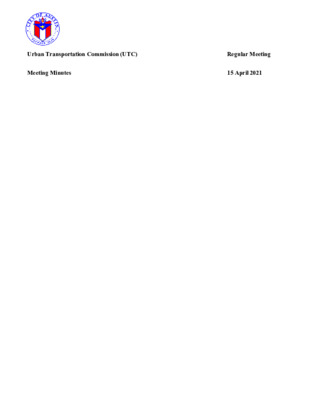
Urban Transportation Commission (UTC) Meeting Minutes Regular Meeting 15 April 2021 The Urban Transportation Commission convened in a meeting on April 15, 2021 via videoconference. Commission Members in Attendance: Mario Champion, Chair Susan Somers Nathan Ryan Daniel Alvarado Athena Leyton Allison Runas Commission Members Absent: Michael Wilfley Alex Reyna CALL TO ORDER Commissioner Champion called the meeting to order at 5:49 p.m. Samuel Franco Cynthia Weatherby 1. APPROVAL OF MINUTES: March 30, 2021 MEETING Diana Wheeler The March 30, 2021 minutes were approved on a 6-0 vote with Commissioners Franco, Reyna, Weatherby, and Wilfley absent. 2. NEW BUSINESS A. Discussion and Possible Action Regarding Corridor Construction Program Update Members were briefed and took no action. B. For discussion and possible action: The UTC will discuss, take nominations, and appoint representatives to the following bodies: Joint Sustainability Commission, Bicycle Advisory Council (BAC), and Pedestrian Advisory Council (PAC) Members voted to appoint Commissioner Diana Wheeler to act as the as the Urban Transportation Commission Representative for the Joint Sustainability Commission on a 6-0 vote with Commissioners Franco, Reyna, Weatherby, and Wilfley absent, and Commissioner Wheeler abstaining. Members voted to appoint Commissioner Athena Leyton to act as the as the Urban Transportation Commission Representative for the Bicycle Advisory Commission on a 7- 0 vote with Commissioners Franco, Reyna, Weatherby, and Wilfley absent. Members voted to appoint Commissioner Allie Runas to act as the as the Urban Transportation Commission Representative for the Pedestrian Advisory Commission on a 7-0 vote with Commissioners Franco, Reyna, Weatherby, and Wilfley absent. FUTURE AGENDA ITEMS Commissioner Somers requested an update on Project Connect Community Advisory Committee Healthy Streets Briefing/Update Commissioner Somers requested an update on the Great Streets program update Commissioner Leyton requested an update on the at the Crossing of 35th and 4th street for bicyclists and pedestrians ADJOURNMENT Commissioner Champion adjourned the meeting at 6:49p.m. without objection.
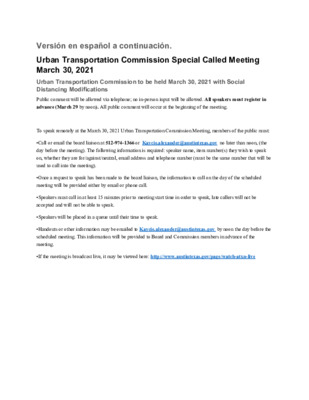
Versión en español a continuación. Urban Transportation Commission Special Called Meeting March 30, 2021 Urban Transportation Commission to be held March 30, 2021 with Social Distancing Modifications Public comment will be allowed via telephone; no in-person input will be allowed. All speakers must register in advance (March 29 by noon). All public comment will occur at the beginning of the meeting. To speak remotely at the March 30, 2021 Urban Transportation Commission Meeting, members of the public must: •Call or email the board liaison at 512-974-1366 or Kaycie.alexander@austintexas.gov no later than noon, (the day before the meeting). The following information is required: speaker name, item number(s) they wish to speak on, whether they are for/against/neutral, email address and telephone number (must be the same number that will be used to call into the meeting). •Once a request to speak has been made to the board liaison, the information to call on the day of the scheduled meeting will be provided either by email or phone call. •Speakers must call in at least 15 minutes prior to meeting start time in order to speak, late callers will not be accepted and will not be able to speak. •Speakers will be placed in a queue until their time to speak. •Handouts or other information may be emailed to Kaycie.alexander@austintexas.gov by noon the day before the scheduled meeting. This information will be provided to Board and Commission members in advance of the meeting. •If the meeting is broadcast live, it may be viewed here: http://www.austintexas.gov/page/watch-atxn-live Reunión Convocado Especial del Urban Transportation Commission la FECHA de la reunion (March 30, 2021) La junta se llevará con modificaciones de distanciamiento social Se permitirán comentarios públicos por teléfono; no se permitirá ninguna entrada en persona. Todos los oradores deben registrarse con anticipación (March 29, 2021 antes del mediodía). Todos los comentarios públicos se producirán al comienzo de la reunión. Para hablar de forma remota en la reunión, los miembros del público deben: • Llame o envíe un correo electrónico al enlace de junta en 512-974-1366 o Kaycie.alexander@austintexas.gov a más tardar al mediodía (el día antes de la reunión). Se requiere la siguiente información: nombre del orador, número (s) de artículo sobre el que desean hablar, si están a favor / en contra / neutral, dirección de correo electrónico (opcional) y un número de teléfono (debe ser el número que se utilizará para llamar ). • Una …
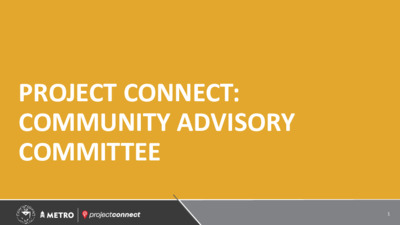
PROJECT CONNECT: COMMUNITY ADVISORY COMMITTEE 11 1 Background • City Council, Capital Metro Board created framework for the “Project Connect Community Advisory Committee” • The committee will advise the City and ATP on $300M anti- displacement investments, equity assessment tool, equity key performance indicators, and Equitable TOD study • Recommendations by the Advisory Committee must be heard by either the City, Capital Metro, or Austin Transit Partnership 2 Membership Considerations • 11 community members • 6 community members appointed by an open application process • 5 community members appointed from within existing City and Capital Metro Boards and Commissions • Members must be a resident of Austin or the Capital Metro Service area and they cannot have a contract for property, goods or services with the City, Capital Metro or Austin Transit Partnership • Membership term is 2 years, with anticipated monthly meetings 3 Open-Application Seats • Application open to the public February 5 – March 5 • Council and Board want a diverse group of participants from a wide array of topic areas, and representing many different communities and demographics in Austin • Nominating Committee reviewed applications and made a recommendation to the full Council and Board for consideration 4 Current Membership Awais Azhar Joao Paulo Connolly Jeremy Hendricks Gretchen Flateau Theodore Fong Renee Lopez Brianna Snitchler Ex Officio Member: Alex Karner *Note: must be confirmed by both Council and Capital Metro Board Open Application Nominees* Susana Almanza Existing Commission & Committee Appointments COA Urban Transportation Commission - tbd COA Mayor’s Committee for People with Disabilities – tbd COA Community Development Commission - Alberto Mejia CapMetro Access Advisory Committee - Otmar Foehner CapMetro Customer Satisfaction Advisory Committee – David Shapiro 5 Timeline Public application for open seats – February 5 through March 5 • Appointments from the three City of Austin Boards and Commissions, and two Capital Metro Committees has begun already and is ongoing Nominating Committee reviews applications and conducts interviews, if needed, between March 1 - 19 Nominating committee makes recommendation to Council and Board for appointment by March 22 March 25 City Council Meeting • March 29 Capital Metro Board Meeting This timeline allows the first meeting of the committee to occur in April 2021 6 Additional Information • Webpage: ProjectConnect.com/Community-Advisory-Committee • Please share! • Questions? 7
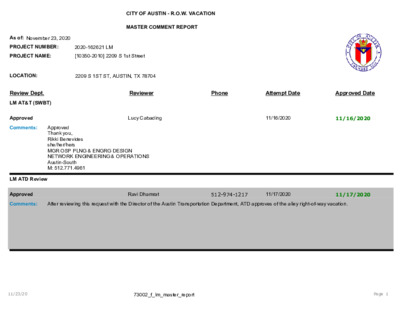
CITY OF AUSTIN - R.O.W. VACATION MASTER COMMENT REPORT As of: November 23, 2020 PROJECT NUMBER: 2020-162621 LM PROJECT NAME: [10350-2010] 2209 S 1st Street LOCATION: 2209 S 1ST ST, AUSTIN, TX 78704 Review Dept. LM AT&T (SWBT) Approved Comments: LM ATD Review Approved Approved Thank you, Rikki Benevides she/her/hers MGR OSP PLNG & ENGRG DESIGN NETWORK ENGINEERING & OPERATIONS Austin-South M: 512.771.4961 Reviewer Phone Attempt Date Approved Date Lucy Cabading 11/16/2020 11/16/2020 Comments: After reviewing this request with the Director of the Austin Transportation Department, ATD approves of the alley right-of-way vacation. Ravi Dhamrat 512-974-1217 11/17/2020 11/17/2020 11/23/20 73002_f_lm_master_report Page 1 As of: November 23, 2020 PROJECT NUMBER: 2020-162621 LM PROJECT NAME: [10350-2010] 2209 S 1st Street LOCATION: 2209 S 1ST ST, AUSTIN, TX 78704 Review Dept. Reviewer Phone Attempt Date Approved Date LM Austin Resource Recovery Review Approved Michael Zavala (512) 974-1837 11/18/2020 11/18/2020 Comments: Do not see any issues with this vacation that would hinder any ARR services in this area. LM AW Infrastructure Management Approved With Conditions Eric Sermeno 512-972-0497 11/13/2020 11/13/2020 Comments: Austin Water (AW) has no objections to the requested 4,357 square-feet, Alley (ROW) Vacation as long the water and wastewater service(s) to adjacent properties are verified and re-routed if needed; and, which is more particularly described as being a portion of a thirteen foot (13-ft) wide alley located in Block 2, South Extension of Bouldin Addition, a subdivision recorded in volume 1, page 94 of the plat records of Travis County, Texas and with an address of 2209 S. 1st Street, Austin, Texas, 78704. 11/23/20 73002_f_lm_master_report Page 2 Review Dept. Reviewer Phone Attempt Date Approved Date Jennifer Back 512-974-6361 11/18/2020 11/18/2020 As of: November 23, 2020 PROJECT NUMBER: 2020-162621 LM PROJECT NAME: [10350-2010] 2209 S 1st Street LOCATION: 2209 S 1ST ST, AUSTIN, TX 78704 LM Drainage Engineering Review Approved Comments: Defer to WPD LM Electric Review Rejected Rosario Navarro 512-322-6754 11/10/2020 Comments: Austin Energy has facilities in the proposed vacation area, this alley must be retained as a PUE as long as the facilities remain. Approved With Conditions Rosario Navarro 512-322-6754 11/12/2020 11/12/2020 Comments: Conditionally approved as long as a PUE is retained in place of the alley, to cover the existing electric facilities. 11/23/20 73002_f_lm_master_report Page 3 Reviewer Phone Attempt Date Approved Date Comments: EMS will support staff recommendation on this request. Milissa Warren (512)972-7234 11/16/2020 11/16/2020 As of: November 23, …
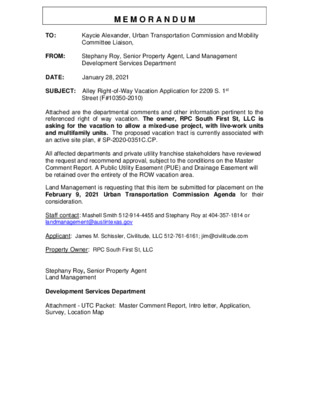
M E M O R A N D U M Kaycie Alexander, Urban Transportation Commission and Mobility Committee Liaison, TO: FROM: DATE: January 28, 2021 SUBJECT: Alley Right-of-Way Vacation Application for 2209 S. 1st Stephany Roy, Senior Property Agent, Land Management Development Services Department Street (F#10350-2010) Attached are the departmental comments and other information pertinent to the referenced right of way vacation. The owner, RPC South First St, LLC is asking for the vacation to allow a mixed-use project, with live-work units and multifamily units. The proposed vacation tract is currently associated with an active site plan, # SP-2020-0351C.CP. All affected departments and private utility franchise stakeholders have reviewed the request and recommend approval, subject to the conditions on the Master Comment Report. A Public Utility Easement (PUE) and Drainage Easement will be retained over the entirety of the ROW vacation area. Land Management is requesting that this item be submitted for placement on the February 9, 2021 Urban Transportation Commission Agenda for their consideration. Staff contact: Mashell Smith 512-914-4455 and Stephany Roy at 404-357-1814 or landmanagement@austintexas.gov Applicant: James M. Schissler, Civilitude, LLC 512-761-6161; jim@civilitude.com Property Owner: RPC South First St, LLC Stephany Roy, Senior Property Agent Land Management Development Services Department Attachment - UTC Packet: Master Comment Report, Intro letter, Application, Survey, Location Map